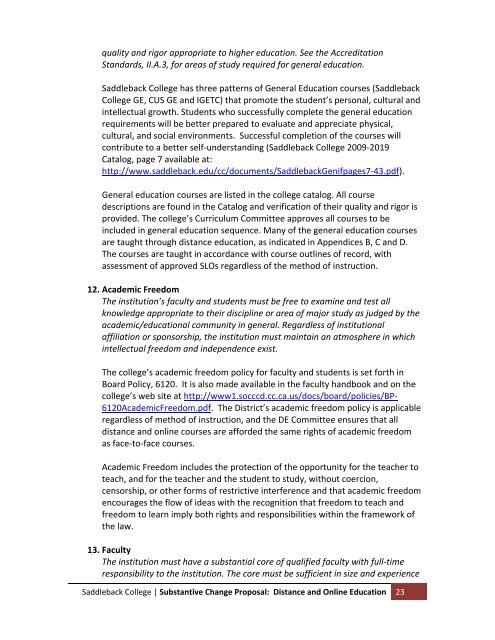Substantive Change Proposal - Saddleback College
Substantive Change Proposal - Saddleback College
Substantive Change Proposal - Saddleback College
Create successful ePaper yourself
Turn your PDF publications into a flip-book with our unique Google optimized e-Paper software.
quality and rigor appropriate to higher education. See the Accreditation<br />
Standards, II.A.3, for areas of study required for general education.<br />
<strong>Saddleback</strong> <strong>College</strong> has three patterns of General Education courses (<strong>Saddleback</strong><br />
<strong>College</strong> GE, CUS GE and IGETC) that promote the student’s personal, cultural and<br />
intellectual growth. Students who successfully complete the general education<br />
requirements will be better prepared to evaluate and appreciate physical,<br />
cultural, and social environments. Successful completion of the courses will<br />
contribute to a better self‐understanding (<strong>Saddleback</strong> <strong>College</strong> 2009‐2019<br />
Catalog, page 7 available at:<br />
http://www.saddleback.edu/cc/documents/<strong>Saddleback</strong>Genifpages7‐43.pdf).<br />
General education courses are listed in the college catalog. All course<br />
descriptions are found in the Catalog and verification of their quality and rigor is<br />
provided. The college’s Curriculum Committee approves all courses to be<br />
included in general education sequence. Many of the general education courses<br />
are taught through distance education, as indicated in Appendices B, C and D.<br />
The courses are taught in accordance with course outlines of record, with<br />
assessment of approved SLOs regardless of the method of instruction.<br />
12. Academic Freedom<br />
The institution’s faculty and students must be free to examine and test all<br />
knowledge appropriate to their discipline or area of major study as judged by the<br />
academic/educational community in general. Regardless of institutional<br />
affiliation or sponsorship, the institution must maintain an atmosphere in which<br />
intellectual freedom and independence exist.<br />
The college’s academic freedom policy for faculty and students is set forth in<br />
Board Policy, 6120. It is also made available in the faculty handbook and on the<br />
college’s web site at http://www1.socccd.cc.ca.us/docs/board/policies/BP‐<br />
6120AcademicFreedom.pdf. The District’s academic freedom policy is applicable<br />
regardless of method of instruction, and the DE Committee ensures that all<br />
distance and online courses are afforded the same rights of academic freedom<br />
as face‐to‐face courses.<br />
Academic Freedom includes the protection of the opportunity for the teacher to<br />
teach, and for the teacher and the student to study, without coercion,<br />
censorship, or other forms of restrictive interference and that academic freedom<br />
encourages the flow of ideas with the recognition that freedom to teach and<br />
freedom to learn imply both rights and responsibilities within the framework of<br />
the law.<br />
13. Faculty<br />
The institution must have a substantial core of qualified faculty with full‐time<br />
responsibility to the institution. The core must be sufficient in size and experience<br />
<strong>Saddleback</strong> <strong>College</strong> | <strong>Substantive</strong> <strong>Change</strong> <strong>Proposal</strong>: Distance and Online Education 23
















